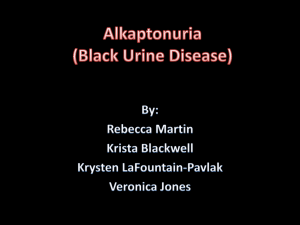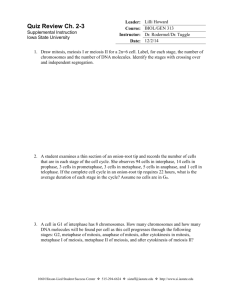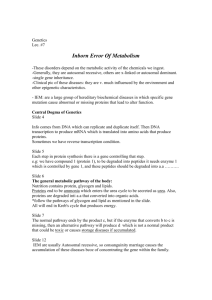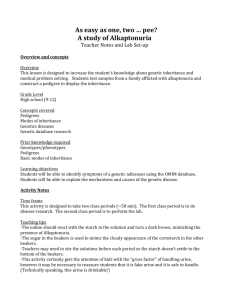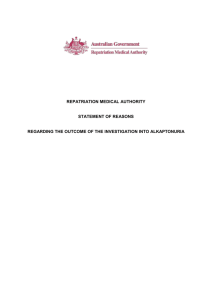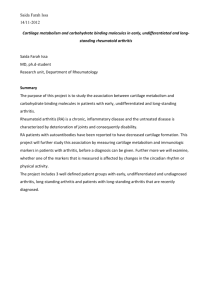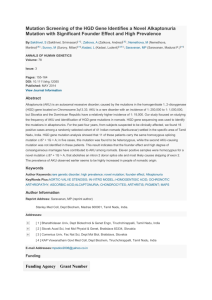Background: Alkaptonuria is a rare “autosomal recessive” inherited
advertisement
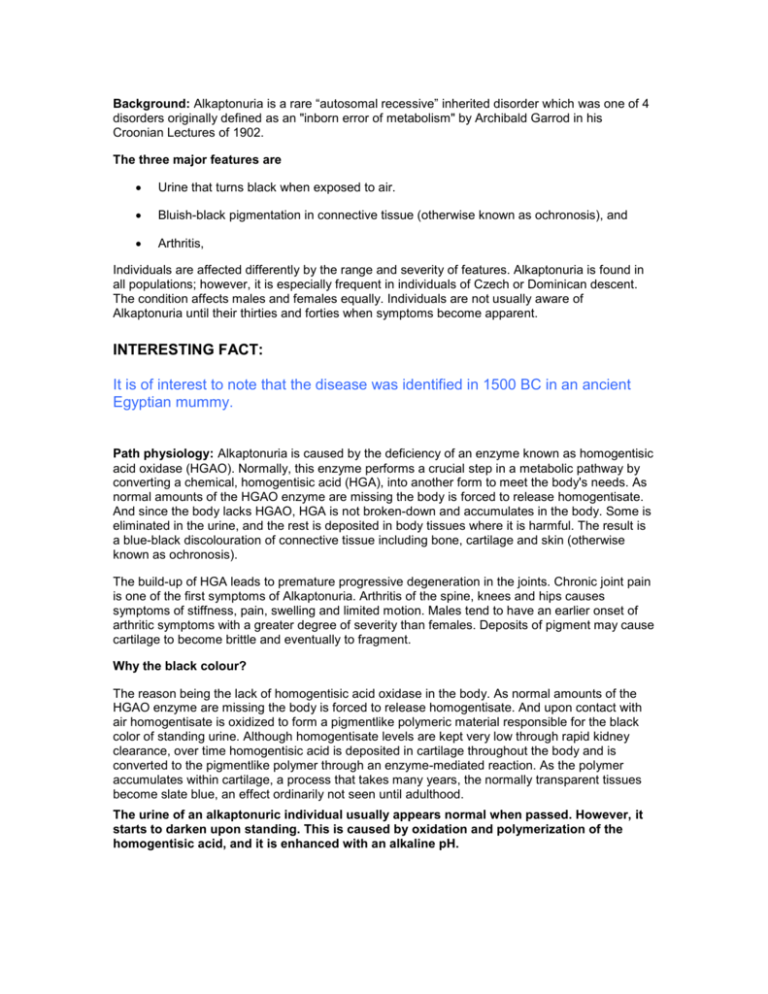
Background: Alkaptonuria is a rare “autosomal recessive” inherited disorder which was one of 4 disorders originally defined as an "inborn error of metabolism" by Archibald Garrod in his Croonian Lectures of 1902. The three major features are Urine that turns black when exposed to air. Bluish-black pigmentation in connective tissue (otherwise known as ochronosis), and Arthritis, Individuals are affected differently by the range and severity of features. Alkaptonuria is found in all populations; however, it is especially frequent in individuals of Czech or Dominican descent. The condition affects males and females equally. Individuals are not usually aware of Alkaptonuria until their thirties and forties when symptoms become apparent. INTERESTING FACT: It is of interest to note that the disease was identified in 1500 BC in an ancient Egyptian mummy. Path physiology: Alkaptonuria is caused by the deficiency of an enzyme known as homogentisic acid oxidase (HGAO). Normally, this enzyme performs a crucial step in a metabolic pathway by converting a chemical, homogentisic acid (HGA), into another form to meet the body's needs. As normal amounts of the HGAO enzyme are missing the body is forced to release homogentisate. And since the body lacks HGAO, HGA is not broken-down and accumulates in the body. Some is eliminated in the urine, and the rest is deposited in body tissues where it is harmful. The result is a blue-black discolouration of connective tissue including bone, cartilage and skin (otherwise known as ochronosis). The build-up of HGA leads to premature progressive degeneration in the joints. Chronic joint pain is one of the first symptoms of Alkaptonuria. Arthritis of the spine, knees and hips causes symptoms of stiffness, pain, swelling and limited motion. Males tend to have an earlier onset of arthritic symptoms with a greater degree of severity than females. Deposits of pigment may cause cartilage to become brittle and eventually to fragment. Why the black colour? The reason being the lack of homogentisic acid oxidase in the body. As normal amounts of the HGAO enzyme are missing the body is forced to release homogentisate. And upon contact with air homogentisate is oxidized to form a pigmentlike polymeric material responsible for the black color of standing urine. Although homogentisate levels are kept very low through rapid kidney clearance, over time homogentisic acid is deposited in cartilage throughout the body and is converted to the pigmentlike polymer through an enzyme-mediated reaction. As the polymer accumulates within cartilage, a process that takes many years, the normally transparent tissues become slate blue, an effect ordinarily not seen until adulthood. The urine of an alkaptonuric individual usually appears normal when passed. However, it starts to darken upon standing. This is caused by oxidation and polymerization of the homogentisic acid, and it is enhanced with an alkaline pH. Ochronosis In the fourth decade, external signs of pigment deposition, called ochronosis, begin to appear. What is Ochronosis? Ochronosis was defined by Virchow who histologically described the connective tissue in alkaptonuria. This is a metabolic abnormality involving the surface of the skin of the face as well as the whites of the eyes, where the tissues become discoloured brown. This can occur due to the long term use of hydroquinone containing agents. It is very commonly seen in South African blacks. Why does it occur? Because normal amounts of the HGAO enzyme are missing, homogentisic acid (HGA) is not used and builds up in the body. Some is eliminated in the urine, and the rest is deposited in body tissues where it is toxic. The result is ochronosis, a blue-black discoloration of connective tissue including bone, cartilage, and skin caused by deposits of ochre-coloured pigment. What are symptoms of alkaptonuria (ochronosis)? Persons affected by alkaptonuria (ochronosis) can note persistent, painless bluish darkening of the outer ears, nose, and whites of the eyes. Symptoms of osteoarthritis can occur at ages that are premature for this form of arthritis, which typically affects persons after the age of 55 years. Heart valves can also become diseased due to ochronosis. How is alkaptonuria (ochronosis Alkaptonuria and ochronosis affect many body systems, as described below. Skeletal (bones and cartilage)--The knees, shoulders, and hips are most affected; arthropathy (diseased joints) is common. Deposits of pigment cause cartilage to become brittle and eventually to fragment (break apart). Cardiovascular (heart and blood vessels)--The aortic and mitral heart valves are most affected. Pigment deposits also can lead to the formation of atherosclerotic plaques (hard spots in arteries) containing cholesterol and fat. Heart valves can also become diseases due to ochronosis. Respiratory (organs and structures involved in breathing)--Heavy pigment deposits in the cartilage of the larynx (voice box), the trachea (windpipe), and the bronchi (air passages to the lungs) are common. Ocular (eyes)--Vision is not usually affected, but pigmentation in the white part of the eye is evident in most patients by their early forties. Cutaneous (skin)--Effects are most noticeable in areas where the body is exposed to the sun and where sweat glands are located. Skin takes on a blue-black speckled discoloration. Other--The teeth, central nervous system (brain and spinal cord), and endocrine organs (which make hormones) also may be affected. Arthropathy (joint disease characterized by swelling and enlarged bones) and discoloration of the skin cause the greatest disability. Arthritis What is arthritis? Arthritis is a joint disorder featuring inflammation. Arthritis literally means inflammation of one or more joints. Arthritis is frequently accompanied by joint pain. Joint pain is referred to as arthralgia. There are many forms of arthritis (over one hundred and growing). The forms range from those related to wear and tear of cartilage (such as osteoarthritis) to those associated with inflammation resulting from an over-active immune system (such as rheumatoid arthritis). Together, the many forms of arthritis make up the most common chronic illness in the United States. The causes of arthritis depend on the form of arthritis. Causes include injury (leading to osteoarthritis), abnormal metabolism (such as gout and pseudogout), inheritance, infections, and for unclear reasons (such as rheumatoid arthritis and systemic lupus erythematosus). These are conditions that are different individual illnesses, with differing features, treatments, complications, and prognosis. They are similar in that they have a tendency to affect the joints, muscles, ligaments, cartilage, tendons, and many have the potential to affect internal body areas. What are symptoms of arthritis? Symptoms of arthritis include pain and limited function of joints. Inflammation of the joints from arthritis is characterized by joint stiffness, swelling, redness, and warm. Tenderness of the inflamed joint can be present. Many of the forms of arthritis, because they are rheumatic diseases, can involve symptoms affecting various organs of the body that do not directly involve the joints. Therefore, symptoms in some patients with arthritis can also include non-specific fever, weight loss, fatigue, and feeling unwell. Who is affected by arthritis? Arthritis affects nearly one in six Americans, or more than 40 million people. This represents 15 percent of the population of the United States. With the aging of the baby boomer generation, the number of people who have arthritis is expected to reach 60 million by the year 2020. Worldwide, some 350 million people suffer from arthritis. How is Alkaptonuria inherited? Alkaptonuria is a classic recessive condition. The gene for it is on a nonsex (autosomal) chromosome. Parents of a person with alkaptonuria each have one alkaptonuric gene and a normal gene paired with it. They have no symptoms of alkaptonuria at all. Each of their children has a one-quarter (25%) chance to receive both of their normal genes, a one-half (50%) chance to receive one alkaptonuric and one normal gene (and seem entirely normal) and a one-quarter (25%) chance to receive both of their alkaptonuric genes and have alkaptonuria (ochronosis). Tt / Tt T t T TT Tt t Tt tt T is the normal gene t is the alkaptonuria gene TT: one-quarter (25%) chance to receive both of their normal genes. Tt: one-half (50%) chance to receive one alkaptonuric and one normal gene (and seem entirely normal). The graph at the TOP shows enzyme activity in three, different sets of individuals - normal (2 "good" genes); parents of affected children (one "good" gene and one "bad" gene); and affected children (two "bad" genes). For most inherited, enzyme deficiency disorders this prediction holds true. There are exceptions but the exceptions provide us with further insight into the structure and function of both enzymes and genes. Who is at risk for Alkaptonuria? People all over the world can have Alkaptonuria. However, doctors know the disease occurs more commonly in some groups of people, including people from Czechoslovakia or the Dominican Republic and their descendants. How might you know if you have Alkaptonuria? Sometimes, dark urine stains in diapers can indicate that a baby has Alkaptonuria. Usually, However, there are no signs until adulthood. In adults, the clearest signs of Alkaptonuria are: Painful joints, especially in the back, hips, and knees. Unusual brown or dark blue coloring on the ear. Dark spots in the whites of the eye. Urine that turns dark if it is exposed to air for several hours. Dark bones, which may be noticed only by doctors during operations. Treatment Medical Care: In infancy, a history of dark-stained diapers should alert the physician. For infants, young children, and asymptomatic young adults, evaluation by simple urine testing can be done on an outpatient basis. Reduction of phenylalanine and tyrosine reportedly has reduced homogentisate excretion. Vitamin C, up to 1 g/d, is recommended for older children and adults. The mild antioxidant nature of ascorbic acid helps to retard the process of conversion of homogentisate to the polymeric material that is deposited in cartilaginous tissues. Surgical Care: Older individuals may require removal of lumbar discs with fusion. Hip or knee joint replacement may be necessary. Consultations: Biochemical genetics Neurosurgery Orthopedics Cardiology in older individuals Diet: Reduction of phenylalanine and tyrosine reportedly reduced homogentisate excretion in the urine of a child. In an adult, a similar restriction reportedly had no effect on excretion of the abnormal metabolite. It is not known whether a mild dietary restriction from early in life would avoid or minimize later complications, but such an approach is reasonable. Vitamin C, up to 1 g/d, is recommended for older children and adults. A Pedigree of Alkaptonuria The pedigree shown best fits an autosomal dominant pattern of inheritance: the trait does skip a generation where one parent is affected, about half of the progeny are affected the sexes are equally affected Arthritis Enzyme Activity in Alkaptonuric Patients Garrod predicted that individuals affected with alkaptonuria would be deficient in one of the enzymes in a degradative, biochemical pathway. He had suggested that the specific enzyme was involved in the degradation of homogentisic acid, an intermediate in the breakdown pathway of phenylalanine and tyrosine. He came to this conclusion by feeding homogentisic acid to alkaptonuric patients and noting that the chemical was excreted in the urine in quantitatively similar amounts to what was administered. It took 50 years until it became possible to assay the various enzymes in this pathway from liver biopsies of normal subjects and those affected with alkaptonuria. The data are show to the right. It is clear that the enzyme activities for both types of individuals are virtually identical except for the enzyme homogenetisic oxidase. This enzyme converts homogentisic acid to maleylacetoacetic acid and a deficiency for this enzyme would allow for homogentisic acid to accumulate in cells and be excreted in the urine. Complications Accumulation of homogentisic acid products in the cartilage causes arthritis in about 50% of older adults with alkaptonuria. Homogentisic acid products can accumulate on the heart valves, especially the mitral valve, sometimes leading to the need for valve replacement. Coronary artery disease may develop earlier in people with alkaptonuria. Kidney and prostate stones may be more common in people with alkaptonuria. ARTHROSCOPIC SURGERY Arthroscopy is an advanced surgical procedure that utilizes a small fiberoptic camera in combination with small surgical tools (about the size of a pencil) to examine and repair a joint through small incisions. Many problems or injuries of the shoulder, knee, and ankle can be treated and cured through arthroscopic surgery. Arthroscopy is usually performed on an outpatient basis and patients usually have a rapid recovery and rapid return to normal activity. LIGAMENT RECONSTRUCTION Anterior Cruciate Ligament (ACL) Reconstruction is a very demanding procedure. It requires extreme accuracy and precision. If the ligament is misplaced by only a few millimeters, the reconstruction is doomed to failure. The success of the procedure is also very dependent on proper post-op rehabilitation. Improper rehabilitation programs can cause the reconstructed ligament to stretch out and fail. MENISCUS REPAIR A Meniscus Tear is the most common intra-articular injury of the knee. The meniscus is the primary shock-absorber of the knee and its preservation is crucial to prevent progressive degeneration of the knee. Dr. O'Meara is a published authority on meniscus repair. The surgical technique that Dr. O'Meara utilizes provides a 20% higher success rate over traditional methods. The molecular basis of alkaptonuria. Fernandez-Canon JM, Granadino B, Beltran-Valero de Bernabe D, Renedo M, Fernandez-Ruiz E, Penalva MA, Rodriguez de Cordoba S Nat Genet 1996 Sep;14(1):19-24 Alkaptonuria (AKU) occupies a unique place in the history of human genetics because it was the first disease to be interpreted as a mendelian recessive trait by Garrod in 1902. Alkaptonuria is a rare metabolic disorder resulting from loss of homogentisate 1,2 dioxygenase (HGO) activity. Affected individuals accumulate large quantities of homogentisic acid, an intermediary product of the catabolism of tyrosine and phenylalanine, which darkens the urine and deposits in connective tissues causing a debilitating arthritis. Here we report the cloning of the human HGO gene and establish that it is the AKU gene. We show that HGO maps to the same location described for AKU, illustrate that HGO harbours missense mutations that cosegregate with the disease, and provide biochemical evidence that at least one of these missense mutations is a loss-of-function mutation. What is alkaptonuria? Alkaptonuria is a rare disease that is inherited. The disease results from a deficiency of the enzyme homogentisic acid oxidase. This enzyme deficiency leads to a build up of homogentisic acid in tissues of the body. Alkaptonuria is known to be especially frequent in Slovakia and in the Dominican Republic. How is alkaptonuria inherited? Alkaptonuia is a classic recessive condition. The gene for it is on a nonsex (autosomal) chromosome. Parents of a person with alkaptonuria each have one alkaptonuric gene and a normal gene paired with it. They have no symptoms of alkaptonuria at all. Each of their children has a one-quarter (25%) chance to receive both of their normal genes, a one-half (50%) chance to receive one alkaptonuric and one normal gene (and seem entirely normal) and a one-quarter (25%) chance to receive both of their alkaptonuric genes and have alkaptonuria (ochronosis). What is ochronosis? Ochronosis is the darkening of the tissues of the body that is caused by pigment composed of the excess homogentisic acid in patients with alkaptonuria. The pigment accumulates in the cartilage of the joints and ears, skin, and whites (sclerae) of the eyes. Bluish discoloration of the nails is also characteristic. How does alkaptonuria affect the joints? Alkaptonuria leads to premature progressive degeneration of the cartilage of the joints due to the accumulation of homogentisic acid in the cartilage. This results in osteoarthritis of joints throughout the body at an unusually early age. Typical joints affected include the spine, knees, hips, and shoulders. Joint symptoms include stiffness, pain, swelling, and limited motion. Other causes of ochronosis that mimic alkaptonuria include the prolonged administration of quinacrine (atabrine) and the use of some bleaching creams used by black women to lighten their complexion (the offending creams contain hydroquinone). What are symptoms of alkaptonuria (ochronosis)? Persons affected by alkaptonuria (ochronosis) can note persistent, painless bluish darkening of the outer ears, nose, and whites of the eyes. Symptoms of osteoarthritis can occur at ages that are premature for this form of arthritis, which typically affects persons after the age of 55 years. Homogentisic acid accumulated in the urine will cause it to turn black. The urine from a person with alkaptonuria turns dark on standing if it is alkaline. (Alkaptonuria was easily diagnosed among the nomadic Bedouin peoples because people with the disease left a characteristic dark spot in the sand marking the spot where they had urinated). Calcification of cartilage can be detected on x-ray testing. In males, calcification of the prostate gland can occur. Heart valves can also become diseased due to ochronosis. How is alkaptonuria (ochronosis) diagnosed? The doctor will suspect alkaptonuria (ochronosis) when the patient reports the abnormal black color in the urine. Bluish discoloration of the eyes, ears, or nose will also suggest the disease. Elevated levels of homogentisic acid in urine and blood samples confirm the diagnosis. How is alkaptonuria (ochronosis) treated? There is no effective treatment for the underlying enzyme deficiency of alkaptonuria. Ascorbic acid (vitamin C) has been found to prevent pigment deposits. Degenerative joint symptoms are treated as for degenerative arthritis (osteoarthritis) of any cause. Treatment of osteoarthritis is reviewed elsewhere. Sometimes joint surgery can be helpful, including arthroscopy and joint replacement. Future treatments for alkaptonuria might involve gene alteration therapies. Where is the alkaptonuria gene and why is the disease unique in genetics (the study of heredity)? The gene for alkaptonuria has been mapped to chromosome number 3 in the region of bands 3q21- q23. The gene for the enzyme homogentisate 1,2-dioxygenase (HGD) has been found to map to exactly the same location. A human gene known as the HGO gene has proven to be synonymous with HGD. And, most importantly, it is now quite clear that alkaptonuria is due to mutations at this genetic locus (spot) on chromosome 3. Alkaptonuria enjoys the historic distinction of being one of the conditions for which recessive inheritance was first proposed. This prescient proposal was made in 1902 by the English physician Archibald Garrod, later Sir Archibald. In a series of brilliant lectures in 1908 Garrod set forth the charter group of what he called "inborn errors of metabolism." The 4 conditions he labeled as inborn errors were albinism, cystinuria, pentosuria and, of course, alkaptonuria. Alkaptonuria is also known as homogentisic acid oxidase deficiency. Alkaptonuria is a genetic disorder due to a deficiency of an enzyme necessary to break down HGA. Ochronotic pigmentation can develop from medications. Similar skin and cartilage alterations can be induced by quinacrine administration and at sites of quinine injections. Quinines directly inhibit homogentisic acid oxidase. Carbolic acid topical applications to cutaneous ulcers have also induced ochronotic skin alterations. Exogenous ochronosis has been reported with topical applications of phenol and hydroquinones to the skin. In the case of hydroquinone, it is reported that 35% of African blacks exhibit ochronotic skin changes when using a 6-8% hydroquinone preparation over a prolonged period. Indeed, the prevalence among users of these skin lighteners has been stated to be 69% in a South African study. In African Americans, this cutaneous adverse effect of hydroquinones has been reported, even when using 2% hydroquinone products. With exogenous ochronosis, the arthropathy seen with alkaptonuria does not occur. Medical Care: Although no present medical treatment is available for alkaptonuria, genetic advances offer hope that corrective measures are forthcoming. Of note, in a murine model of alkaptonuria, 2(2-nitro-4-trifluoromethylbenzoyl)-1,3-cyclohexanedione (MTBC) was shown to be a potent inhibitor of p-hydroxyphenylpyruvate dioxygenase, which catalyzes the formation of HGA. Development of this lead compound may result in the first potent pharmacotherapeutic agent for this metabolic disease. Ochronotic arthropathy is treated with physiotherapy, analgesia, rest, and prosthetic joint replacement when necessary. Surgical Care: With exogenous cutaneous ochronosis induced by topical hydroquinones, carbon dioxide lasers and dermabrasion have been reported to be curative. Consultations: Consultations with a rheumatologist for the arthropathies that develop should be considered. An expert in medical genetics may be of assistance in screening families for this autosomal recessive metabolic disorder. A cardiac assessment and follow-up care are needed upon entering the fourth decade of life. Activity: Activities are restricted in adult life because of arthritic complaints. Further Outpatient Care Patients need cardiovascular follow-up care upon entering their fourth decade of life. Complications: Complications of alkaptonuria include arthropathy and possible cardiovascular disease. Prognosis: Patients with alkaptonuria can expect a normal life span; nevertheless, the complications of debilitating arthritis, cardiovascular compromise, and ochronotic skin alterations will occur. Patient Education: Patients with alkaptonuria need to know that they will have a normal life span, despite pigmentary alterations and arthritis that materialize in mid life. Patients need cardiovascular follow-up care in their later years. With the discovery of lead compounds, such as MTBE, patients should be optimistic that a cure to this disease may surface in the coming years. Why the black colour? The reason being the lack of homogentisic acid oxidase in the body. As normal amounts of the HGAO enzyme are missing the body is forced to release homogentisate. And upon contact with air homogentisate is oxidized to form a pigmentlike polymeric material responsible for the black color of standing urine. Although homogentisate levels are kept very low through rapid kidney clearance, over time homogentisic acid is deposited in cartilage throughout the body and is converted to the pigmentlike polymer through an enzyme-mediated reaction. As the polymer accumulates within cartilage, a process that takes many years, the normally transparent tissues become slate blue, an effect ordinarily not seen until adulthood. The urine of an alkaptonuric individual usually appears normal when passed. However, it starts to darken upon standing. This is caused by oxidation and polymerization of the homogentisic acid, and it is enhanced with an alkaline pH. This paradox can be resolved by collecting a bit more data on the family in this pedigree. As can be seen, there are two instances of consanguinous matings in the pedigree and the pattern of inheritance in the complete pedigree best fits with an autosomal recessive pattern. For rare, recessive traits, the parents of affected individuals are likely to be related in some way.
